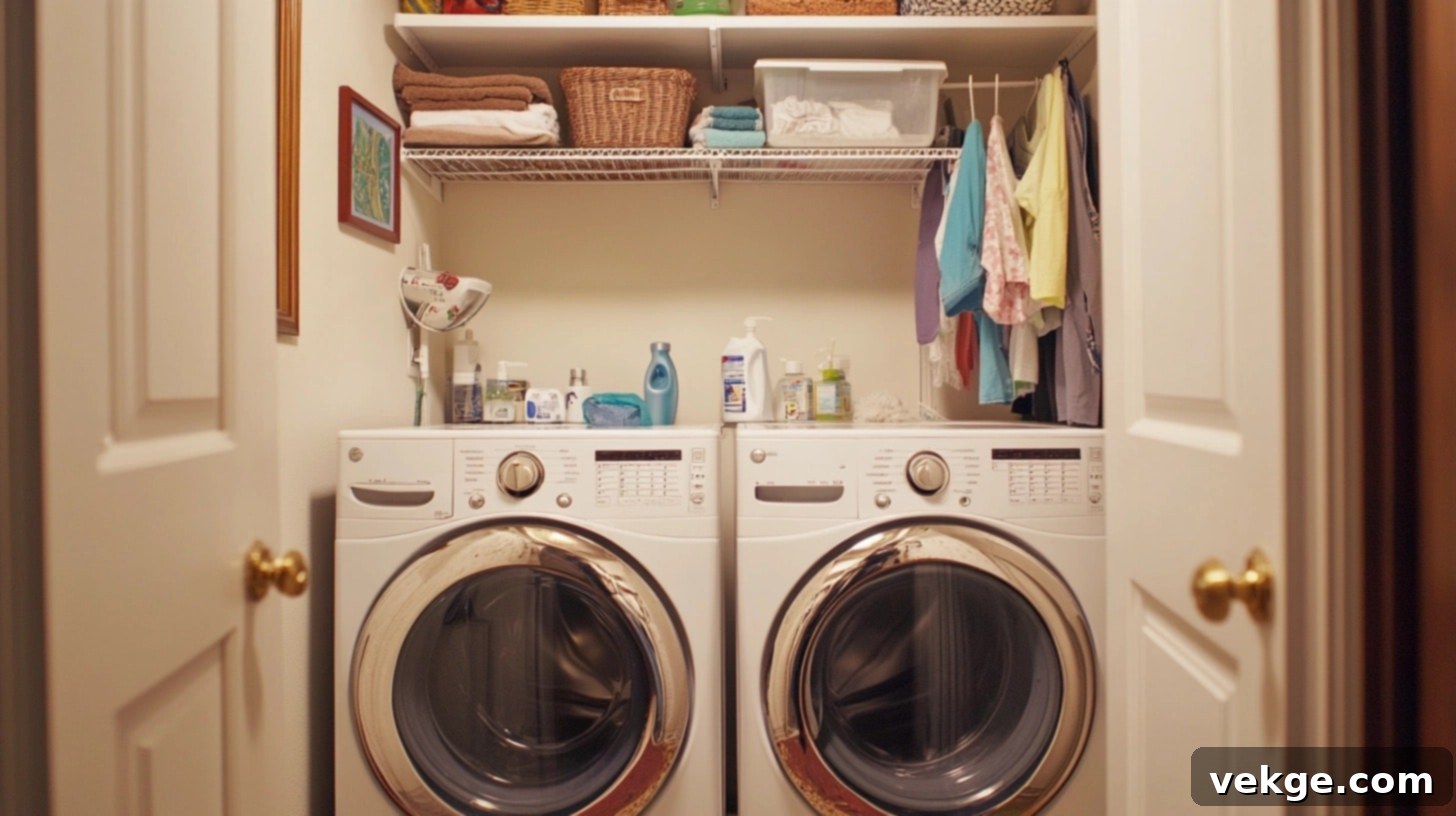Transform Your Tiny Laundry Closet: The Ultimate DIY Guide to Organization & Efficiency
Do you ever feel overwhelmed by your laundry closet? That cramped, disorganized corner where piles seem to multiply, and finding your laundry detergent feels like a treasure hunt? You’re not alone. For years, I wrestled with a minuscule washing space, constantly feeling stuck and frustrated. But through trial and error, I discovered effective strategies to turn that once-dreaded corner into a neat, highly functional area that actually makes laundry less of a chore.
This comprehensive guide is designed to empower you to create a better, more efficient laundry area, regardless of your space limitations or budget constraints. We’ll dive deep into practical planning, intelligent storage solutions, and establishing a system that truly works for your lifestyle. Get ready to banish the chaos and welcome a beautifully organized laundry space that perfectly fits your needs, making laundry day surprisingly manageable and even enjoyable.
DIY Laundry Room Makeover: A Step-By-Step Transformation
Embarking on a DIY laundry room or closet makeover can be incredibly rewarding. It allows you to customize the space to your exact needs, reflecting your personal style while maximizing functionality. Follow this detailed guide to transform your laundry area into an organized haven.
Tools and Materials You’ll Need for Your Laundry Makeover
Having the right tools and materials on hand is crucial for a smooth and successful DIY project. Here’s a comprehensive list of what you’ll need, along with descriptions to help you understand their purpose:
| Tool/Material | Description |
|---|---|
| Plywood | Essential for constructing sturdy shelves, a new base for your machines, or even custom cabinetry. Opt for a thickness suitable for supporting weight without bowing. |
| Wallpaper | Peel-and-stick varieties are incredibly user-friendly for a quick, aesthetic update. Look for sales to keep costs down and choose a design that brightens the space. |
| Brad Nailer | A pneumatic or electric brad nailer is perfect for securing decorative trim pieces, giving your shelves and cabinets a clean, finished look without visible screw heads. |
| Construction Screws | Various sizes will be needed for securing wood framing, shelf supports, and cabinet mounting. Always use screws long enough to penetrate studs for secure installation. |
| Drill | An indispensable tool for unscrewing existing fixtures, driving new screws for shelves and cabinets, and pre-drilling holes to prevent wood splitting. |
| Spackle | Used to patch any holes, cracks, or imperfections in the walls left by previous installations. Ensures a smooth surface for painting or wallpapering. |
| Sandpaper | After spackle dries, sandpaper is used to smooth the patched areas, making them flush with the rest of the wall surface for a professional finish. |
| Wood Glue | Provides extra strength and stability when joining wood pieces, especially for trim. Apply a thin, even layer before nailing. |
| Miter Saw | Crucial for making precise, straight, and angled cuts on plywood, trim, and other wood pieces. Ensures a professional fit for all components. |
| Stud Finder | Locates wall studs, which are essential for securely mounting heavy items like shelves and cabinets. Installing into studs prevents items from pulling out of the drywall. |
| Tape Measure | Accuracy is key in any DIY project. A reliable tape measure is needed for all measurements, from cutting wood to placing shelves. |
| Paint (e.g., “Blue Dress”) | Satin finish paint is often recommended for laundry areas due to its durability and easy-to-clean surface. Choose a color that complements your wallpaper and personal aesthetic. |
| Paint Roller and Brush | A roller is ideal for quickly covering large wall surfaces, while an angled brush allows for precise cutting-in around edges, trim, and outlets. |
| Stain (for Shelves and Cabinet Trim) | If you’re using raw wood, stain allows you to match new elements to existing cabinetry or create a desired wood tone. Test on a scrap piece first. |
| Shelf Brackets and Screws | Provides robust support for your shelves. Choose brackets appropriate for the weight your shelves will hold and ensure they are properly anchored. |
| Handles (Modern Style) | New handles can instantly update the look of existing or new cabinets. Reusing ones from previous projects is a great budget-friendly and sustainable option. |
| Lint Bin | A magnetic lint bin adheres directly to your dryer, offering a convenient and accessible spot to dispose of lint after each load, promoting safety and cleanliness. |
| Organization Containers | Plastic bins, woven baskets, or clear containers are perfect for neatly storing laundry supplies, keeping your shelves tidy and visually appealing. |
| Level | Absolutely essential for ensuring that all shelves, cabinets, and supports are installed perfectly straight, preventing slanted surfaces and improving aesthetics. |
| Utility Knife/Box Cutter | For precise cuts on wallpaper, opening packages, and other general utility tasks. |
| Squeegee/Smoothing Tool | To smooth out peel-and-stick wallpaper and remove air bubbles, ensuring a flawless application. |
| Caulk Gun & Caulk | For sealing gaps between trim and walls, or around new fixtures, giving a finished, professional look and preventing dust buildup. |
| Safety Glasses & Gloves | Always prioritize safety when working with tools and materials. Protect your eyes and hands. |
Detailed Step-by-Step Guide for Your Laundry Makeover
Step 1: Clear and Prepare the Space for Transformation
- Remove All Items: Begin by completely emptying your laundry room or closet. This includes all existing shelves, racks, and any other fixtures. A blank canvas allows you to accurately assess the space and plan your new layout.
- Patch and Sand: Carefully inspect the walls for any holes, dents, or rough spots left by previous installations. Use a good quality spackle to fill these imperfections. Once dry, sand the patched areas smooth with fine-grit sandpaper until they are flush with the surrounding wall. Clean off any dust with a damp cloth.
Step 2: Install Wallpaper for an Instant Style Boost
- Apply Peel-and-Stick Wallpaper: Starting from the top of the wall and working your way down, carefully apply your peel-and-stick wallpaper. Take your time to align patterns and ensure smooth application. Use a squeegee or a clean, dry cloth to smooth out any air bubbles, pushing them towards the edges.
- Trim Around Outlets and Obstacles: With a sharp utility knife, meticulously cut around electrical outlets, light switches, and any other fixtures. This attention to detail ensures a seamless and professional-looking finish, making the wallpaper appear custom-fitted to your space.
Step 3: Construct and Install Sturdy Shelving
- Measure and Cut Wood: Accurately measure the internal dimensions of your closet where shelves will be installed. Using a miter saw, precisely cut your plywood to these measurements. Remember the adage: “measure twice, cut once!”
- Secure Supports: Employ a stud finder to locate the wall studs where your shelf supports will be mounted. Mark these locations clearly. Install your shelf supports using construction screws, ensuring they are level with a spirit level. This step is critical for the stability and safety of your shelves.
- Attach Shelves: Once the supports are securely in place, carefully position your cut plywood shelves onto the supports. Secure them from underneath or on top with smaller construction screws or a brad nailer for a clean look.
Step 4: Stain and Finish Shelving for a Polished Look
- Apply Stain: If you’re opting for a wood finish, apply your chosen stain to the shelves using a clean cloth or brush. Work in the direction of the wood grain for an even application. Allow the stain to dry completely according to the manufacturer’s instructions. You may apply a second coat for deeper color.
- Attach Trim: To give your shelves a finished, custom-built appearance, cut and secure trim pieces along the front and side edges of the shelves. Use wood glue for a strong bond, followed by a brad nailer for discreet fastening. Fill any nail holes with wood putty and sand smooth before applying any final finish.
Step 5: Paint the Walls for a Fresh Ambiance
- Paint the Closet: With your shelves stained and trimmed, it’s time to paint the remaining wall areas. Use a roller for broad surfaces and an angled brush for precision work around edges, trim, and outlets. Apply an even coat, ensuring full coverage.
- Allow to Dry: Patience is key here. Ensure the paint is completely dry, often requiring several hours or even overnight, before proceeding to the next steps. This prevents smudges and ensures a durable finish.
Step 6: Install Cabinets and Modern Accessories
- Mount Cabinet: If adding an upper cabinet, use your stud finder to locate wall studs above your appliances. Carefully mount the cabinet to these studs using appropriate construction screws, ensuring it is level and secure.
- Attach New Handles: Upgrade the aesthetics of your new or existing cabinet by attaching modern handles. This small detail can make a significant difference in the overall look and feel of the space.
- Replace Outlets and Switches: For a truly refreshed look, consider replacing old, yellowed outlets and light switches with new, crisp white ones that match your updated design. Always turn off power at the circuit breaker before working with electrical components.
Step 7: Organize and Finalize Your New Laundry Oasis
- Reattach Dryer Vent: Ensure the dryer vent hose is securely reattached to both the dryer and the wall vent. Proper ventilation is critical for safety and dryer efficiency. Double-check for any kinks or blockages.
- Organize Items: Now for the fun part! Arrange your laundry supplies, detergents, fabric softeners, and other essentials neatly in your chosen bins, baskets, and containers on the new shelves. Group similar items together for easy access.
- Clean and Decorate: Give your appliances a thorough wipe-down. Add personal touches like a small plant, a framed picture, or a decorative sign. Stand back and admire your beautifully organized and refreshed laundry space!
Smart Organization Tips for Your Laundry Space
An organized laundry area goes beyond aesthetics; it boosts efficiency and reduces stress. Here are eight intelligent organization tips to keep your space functional and tidy:
1. Sort with Clear Containers for Easy Identification
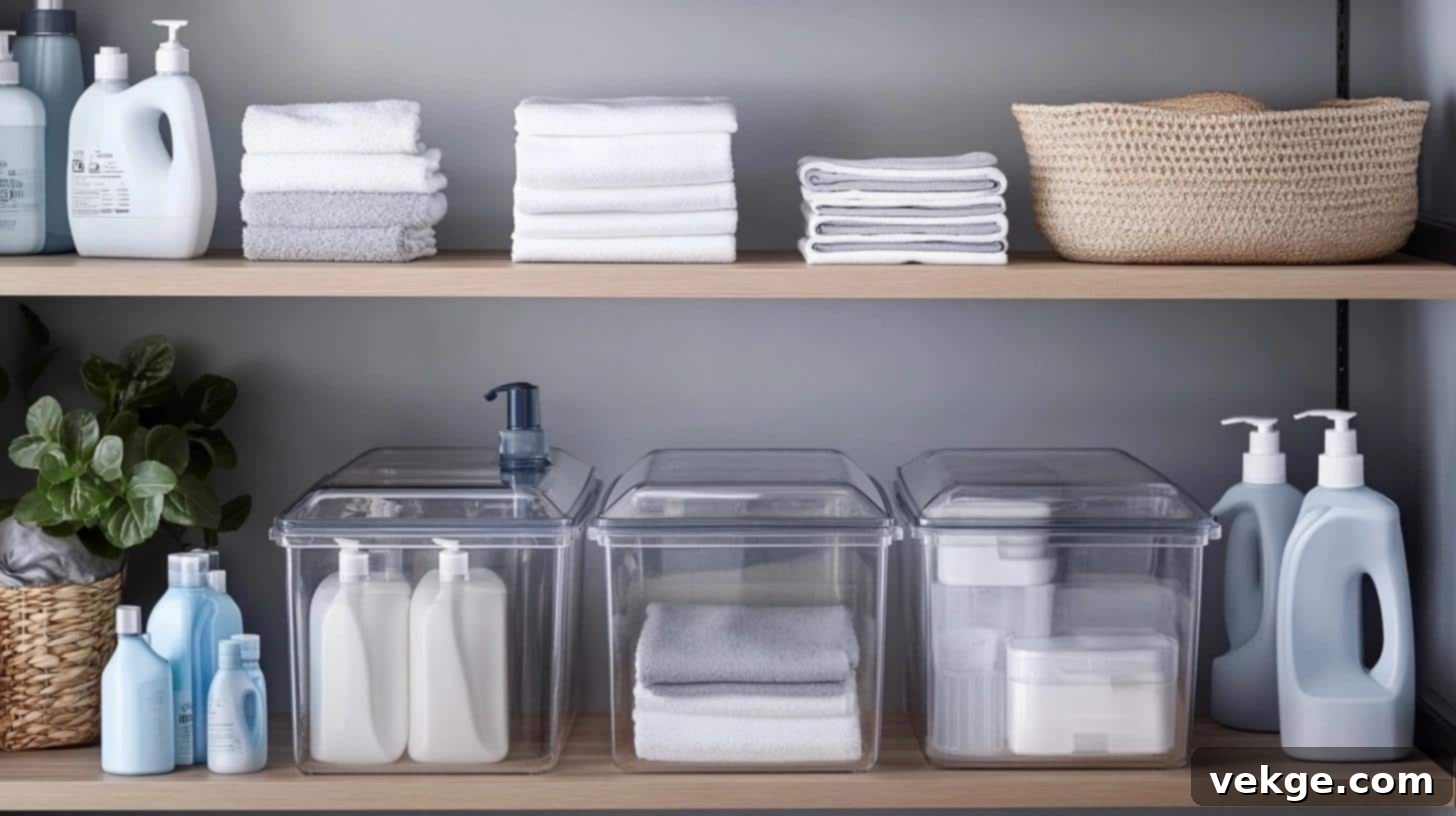
Opt for clear, see-through storage containers. These are invaluable because they allow you to quickly identify contents, making finding supplies quick and simple. Dedicate one container for washing essentials (detergent, scent boosters), another for drying needs (dryer sheets, wool balls), and a specific spot for spot cleaners or stain removers. Store bulk or backup supplies towards the back of the shelves or in less accessible spots. This system not only keeps everything visibly organized but also helps you immediately spot when items are running low, streamlining your shopping list and preventing last-minute rushes.
2. Maximize Every Wall Inch with Strategic Placement
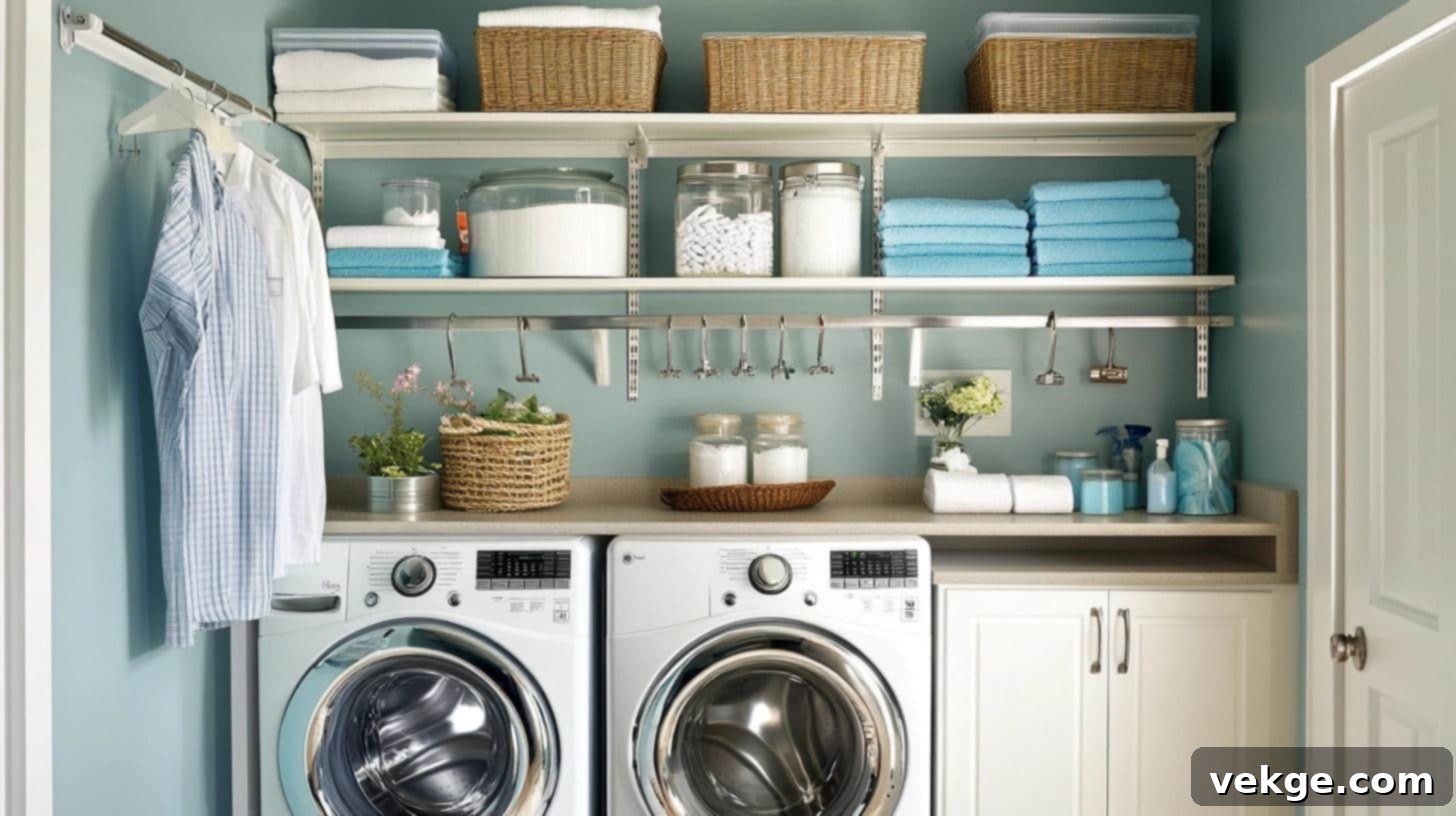
Your walls are prime real estate for storage. Strategically plan where items go based on frequency of use. Keep items you access daily, such as primary detergents or a lint roller, at waist or eye level for effortless reach. Store less frequently used backup supplies, seasonal items, or specialty cleaning products on higher shelves. Install sturdy hooks at eye level for quick grabs of frequently used items like mesh laundry bags or small hand brushes. Lower hooks can be perfect for smaller tools or even a hanging ironing board. By thinking vertically, you free up valuable counter and floor space.
3. Incorporate Smart Hanging Spots for Versatility
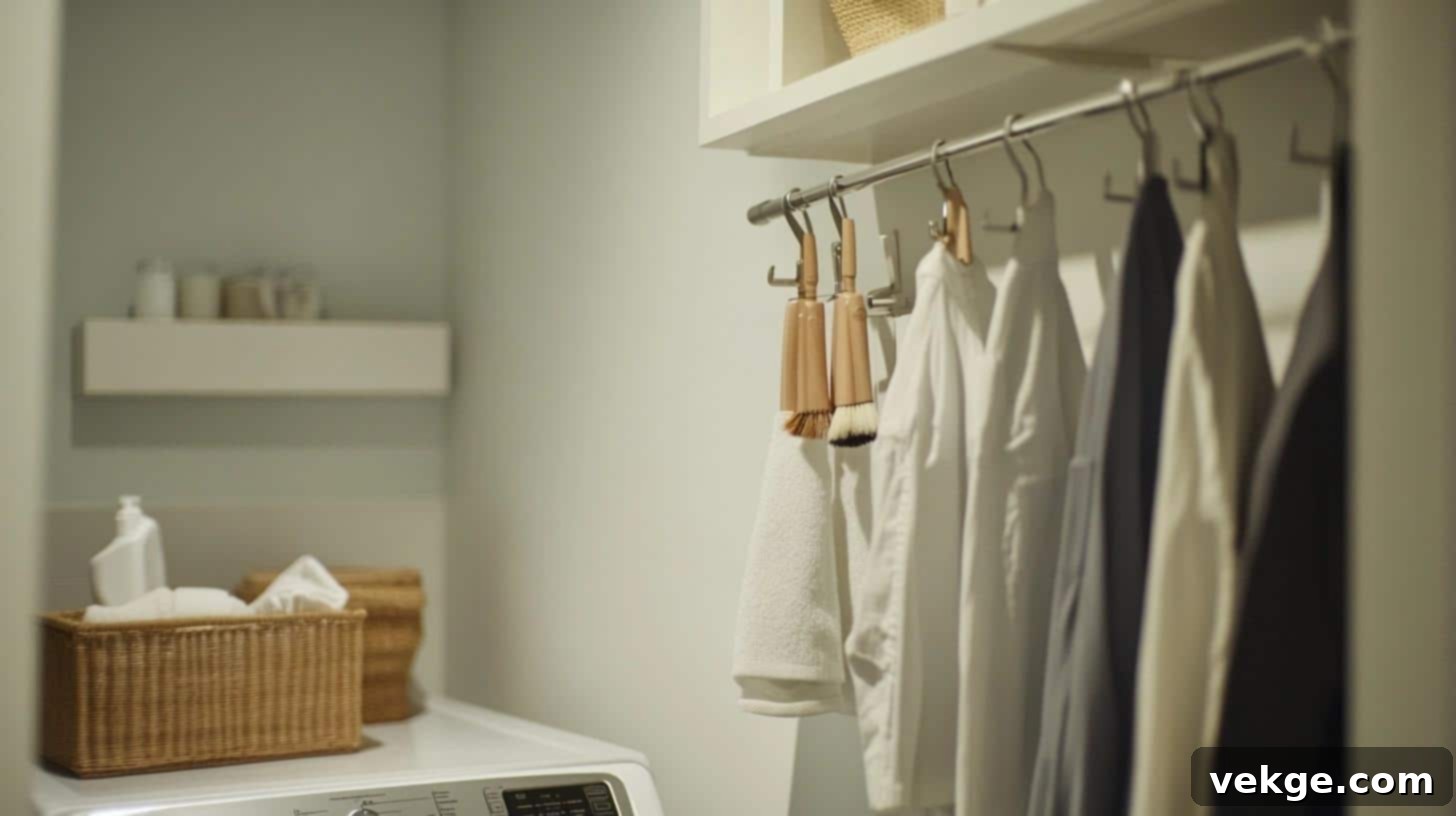
Designate specific hanging spots to prevent clutter and manage various laundry items efficiently. Install sturdy hooks or a small rail near your washer for brushes, scrubbers, and cleaning tools. For items that need to air dry or clothes that need to be hung immediately after drying to prevent wrinkles, a retractable clothesline or a few strong, dedicated hooks are invaluable. Consider a dedicated spot for heavy items like reusable shopping bags or a laundry hamper on wheels when not in use. These thoughtful additions help maintain order and protect garments.
4. Implement a Seamless Lint Management Plan
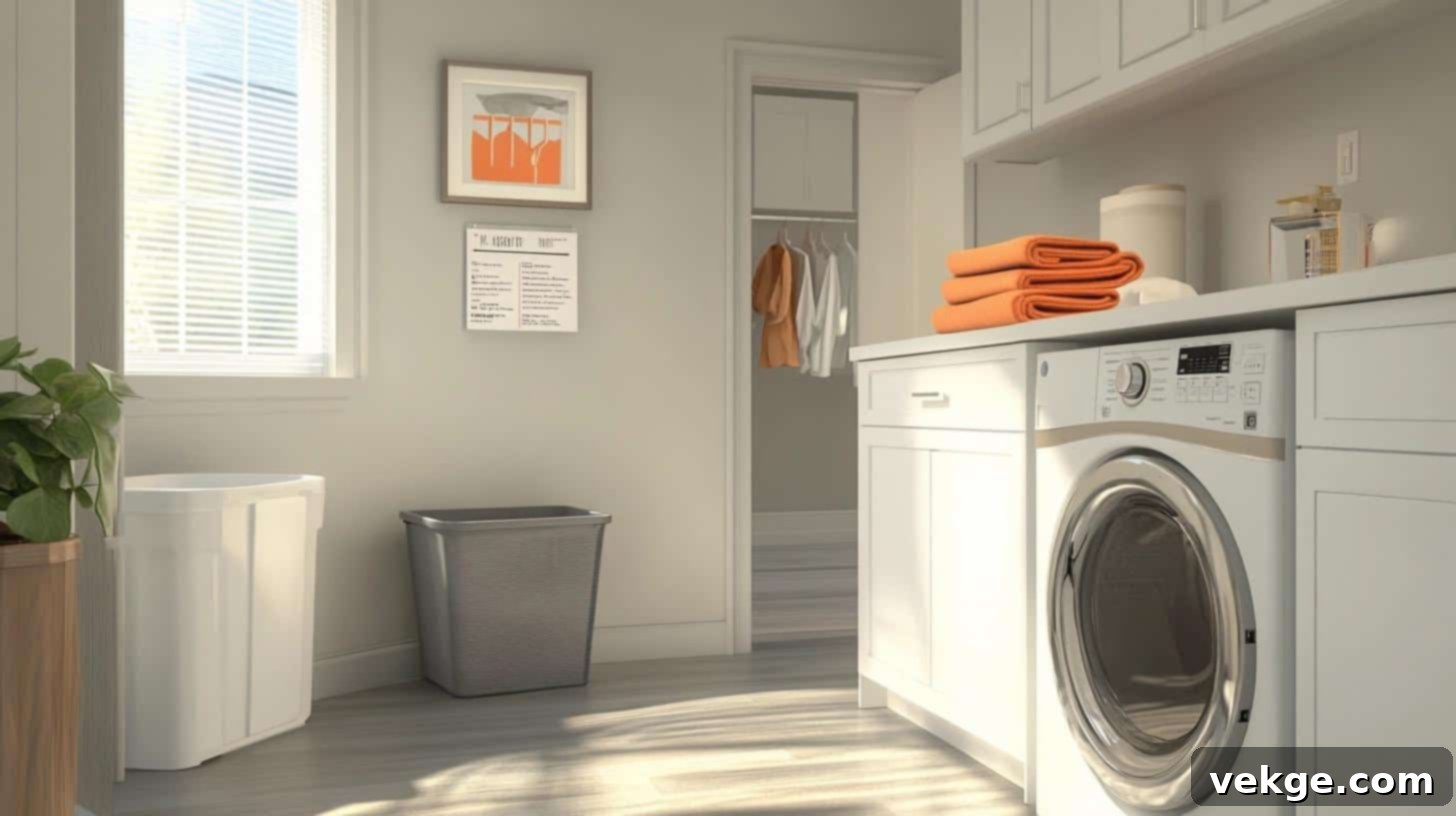
Maintaining a clean and safe laundry space requires a simple yet effective lint control system. Place a small, easily accessible bin, ideally a magnetic one that attaches directly to your dryer, for immediate lint disposal after every load. This habit is critical for fire prevention and dryer efficiency. Beyond the daily clean, make it a point to check and clean the dryer vent hose and exterior vent opening weekly or monthly to prevent significant buildup. Keep extra dryer filters stored nearby, so you can grab them quickly when replacement is needed, ensuring optimal dryer performance.
5. Create Clear Signs and Labels for Consistency
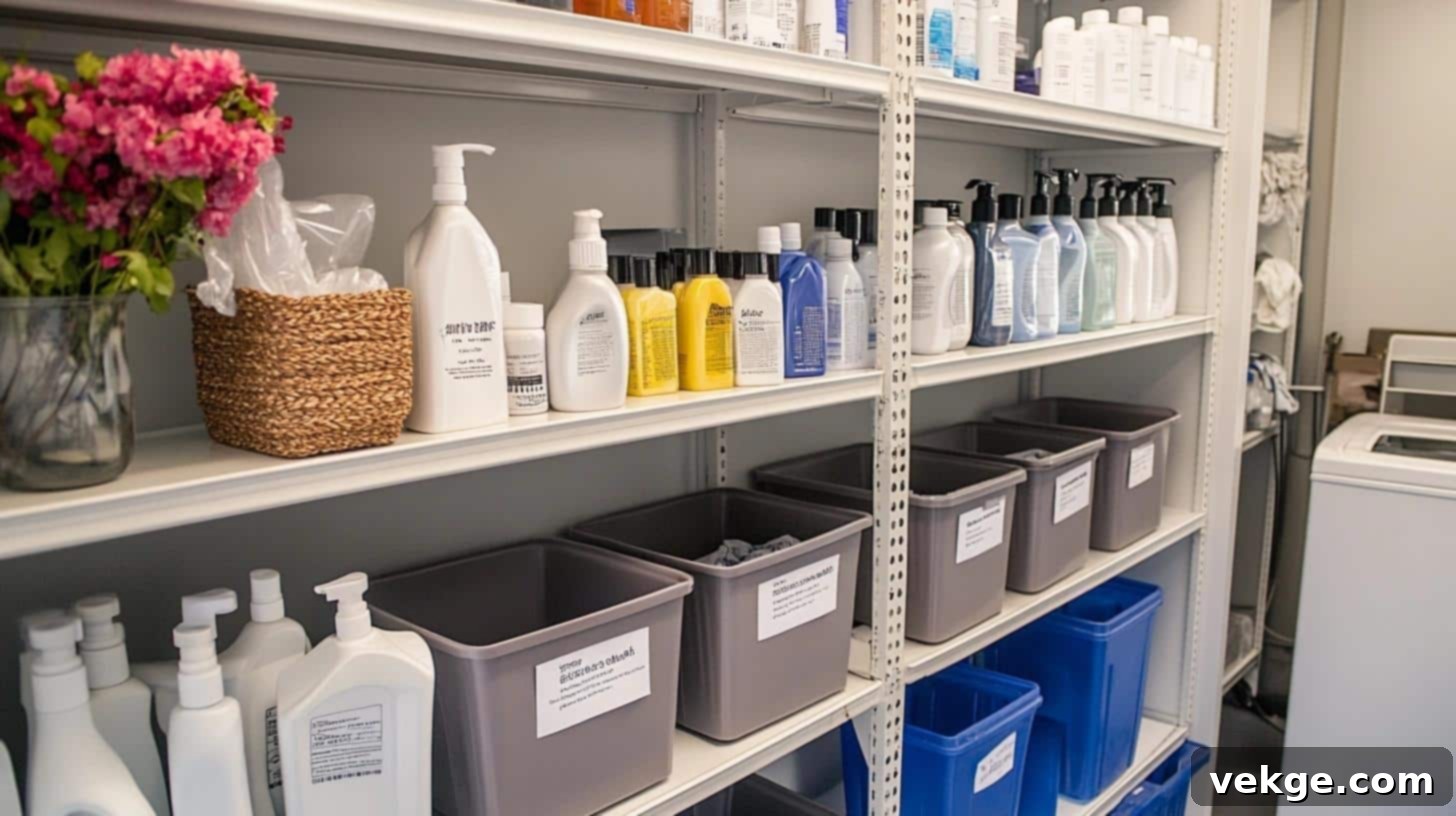
Clear, consistent labeling is paramount, especially in a family household, to ensure everyone follows the same organizational system. Label what goes in each bin (e.g., “Whites,” “Darks,” “Delicates,” “Towels”) and clearly mark containers for different products. Consider putting up basic wash guides or care instructions for common fabrics to prevent laundry mishaps. A visible checklist for supplies can also be a game-changer, helping you track inventory and know exactly what to purchase on your next store run, minimizing guesswork and wasted trips.
6. Designate a Dedicated Work Space for Laundry Tasks
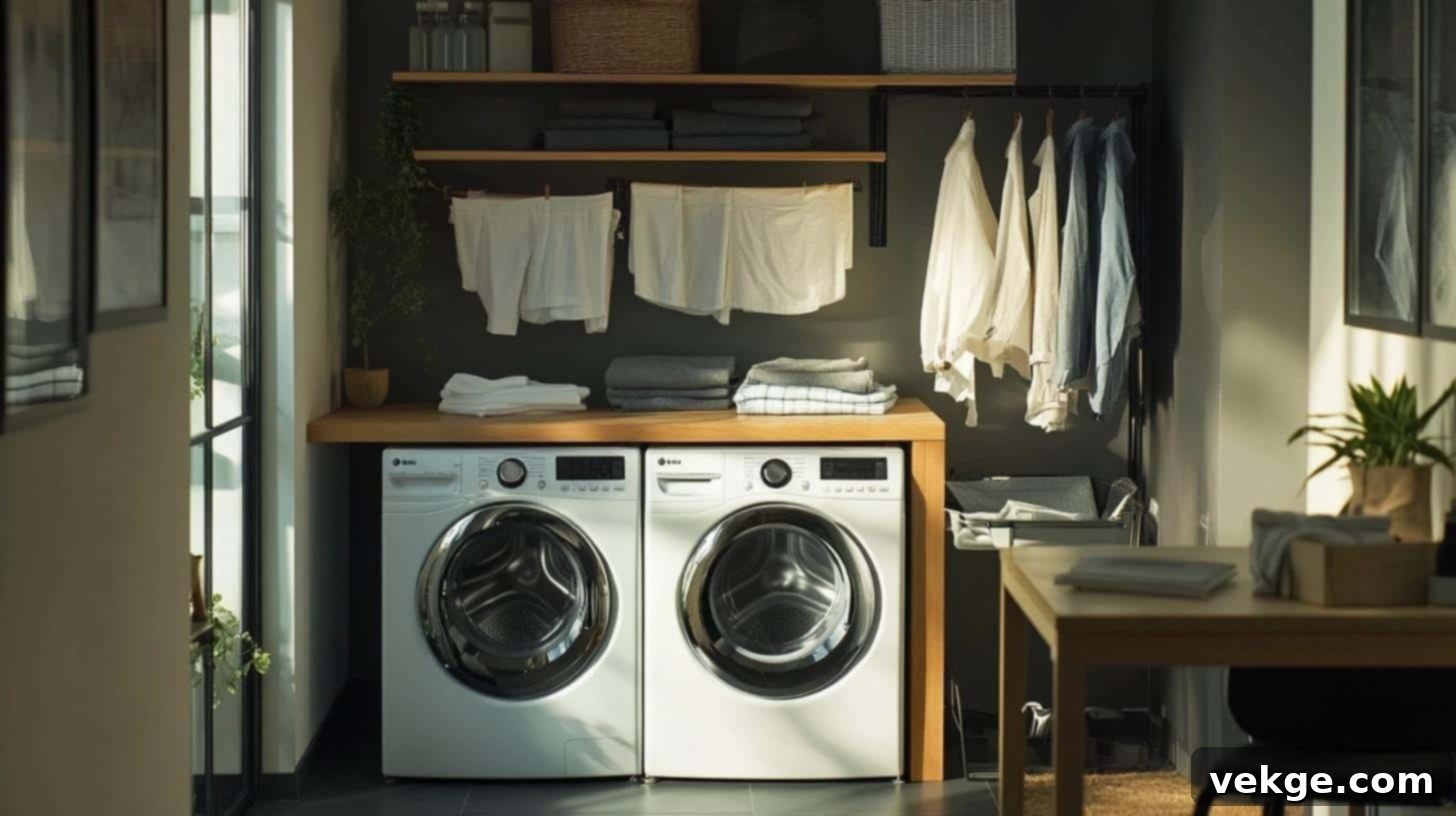
Creating a specific area for handling clean clothes can dramatically improve your laundry routine. Utilize the flat tops of your washing machines by adding a countertop, installing a small pull-down shelf, or incorporating a narrow, portable table if space allows. The key is to have a dedicated surface for sorting, folding, and perhaps even light ironing. This not only keeps your clothes from migrating to other rooms but also encourages you to finish the laundry process immediately, preventing those dreaded “clean clothes piles” from forming and creating visual clutter.
7. Ingeniously Utilize Tight Spaces with Slim Solutions
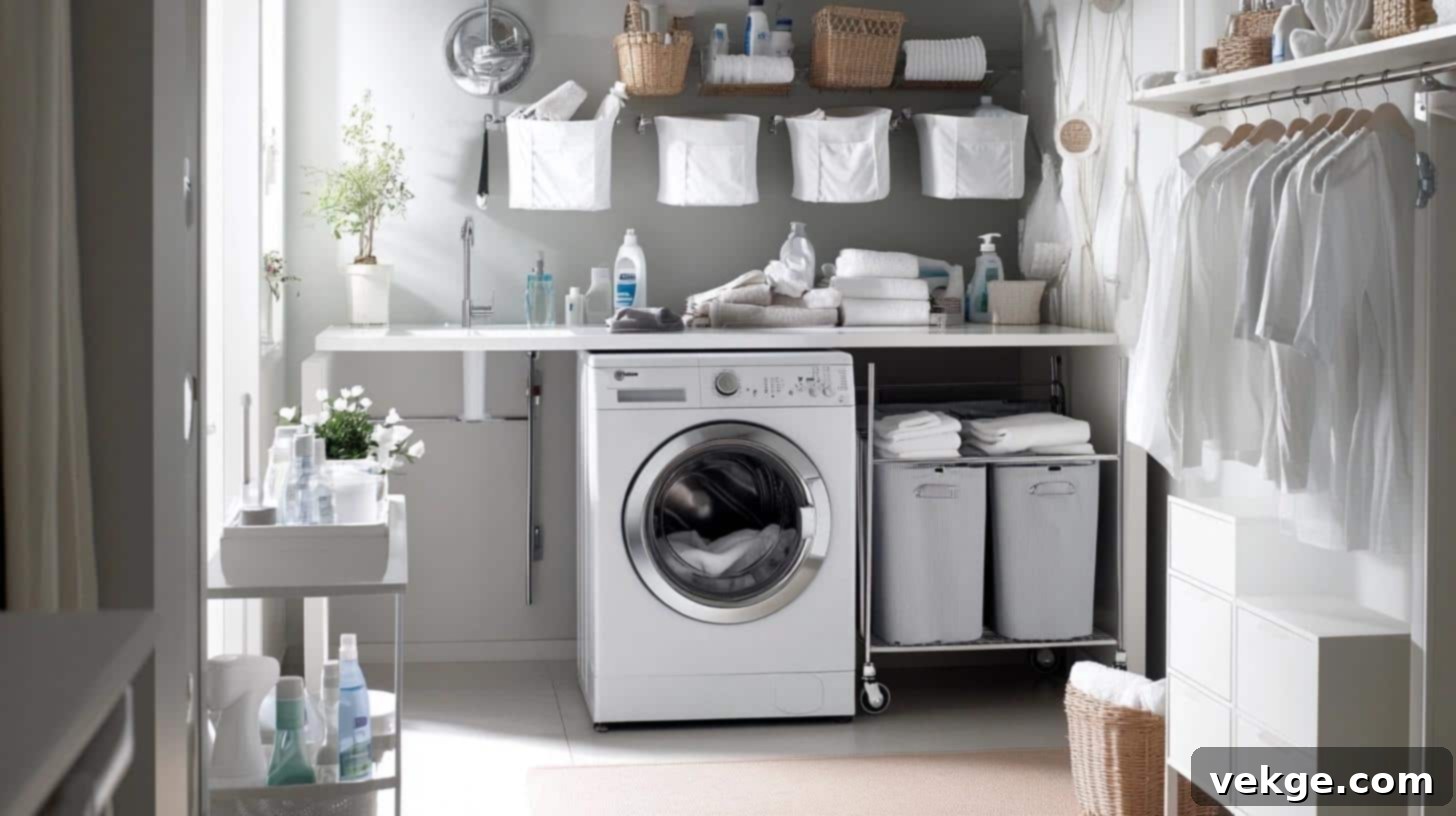
Don’t overlook the potential of small gaps or awkward corners in your laundry area. A thin, rolling cart can slide perfectly into the space between your washer and dryer, providing extra storage for smaller bottles, lint rollers, or cleaning cloths. Wall-mounted pocket organizers on the back of a door or on a narrow wall strip can hold small items like clothespins, dryer balls, or stain sticks. Remember to think vertically in tight spaces; even a few inches of width can hold significant items when shelves or hooks are strategically placed. Every inch counts in maximizing your small laundry space.
8. Group Cleaning Tools for a Centralized Cleaning Station
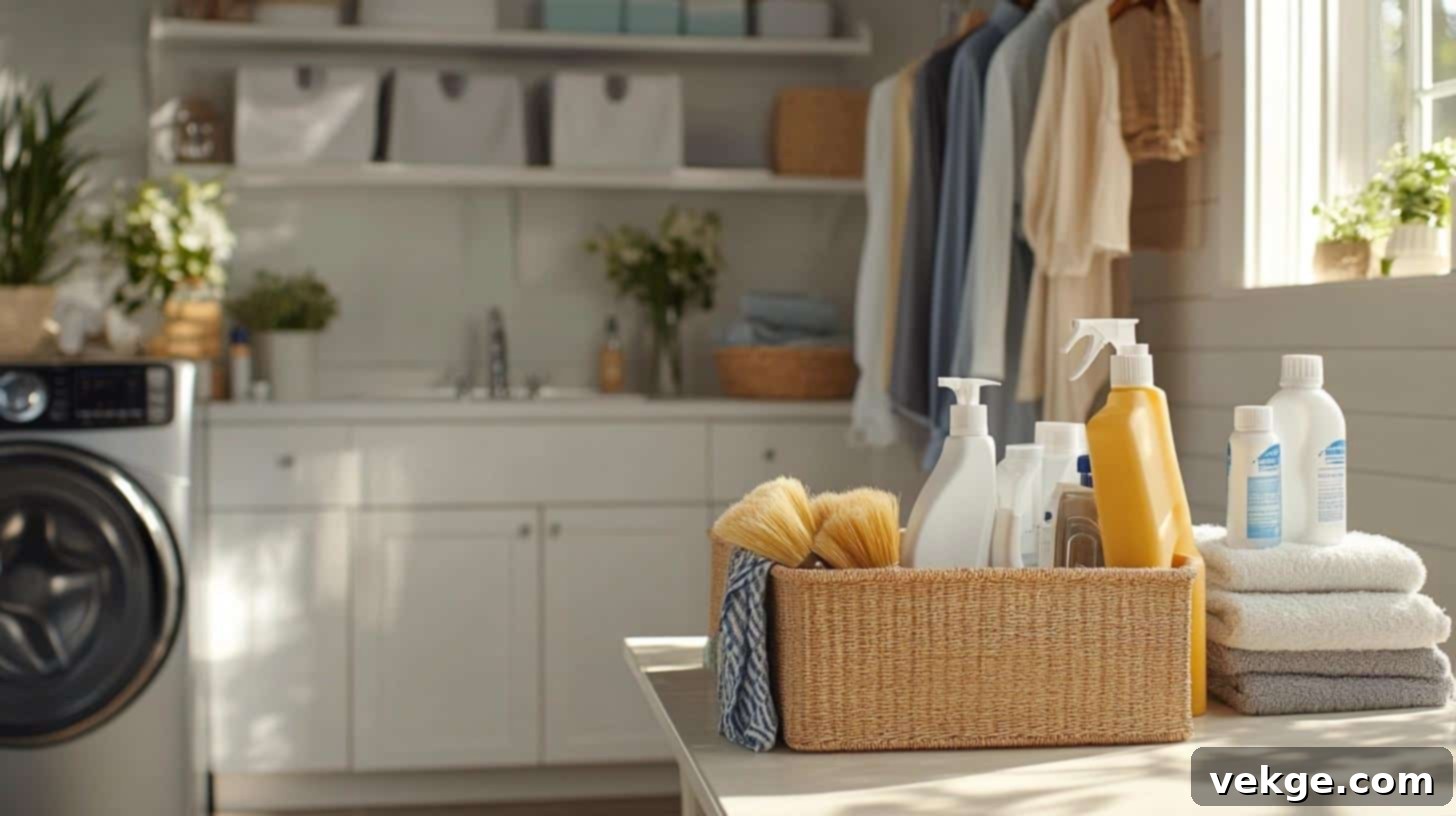
Consolidate all your general household cleaning supplies in one easy-to-grab spot within your laundry space. Store basic all-purpose cleaners, microfiber cloths, sponges, and brushes together, perhaps in a portable caddy. This not only makes it incredibly simple to grab everything you need for a quick clean-up but also ensures that the cleaning supplies for the laundry room itself are readily available. Having a single cleaning station means you’ll instantly notice when a product is running low, simplifying inventory management and ensuring you’re always prepared for spills and tidying tasks.
Budget-Friendly Tips for a Laundry Room Makeover
A stunning laundry room transformation doesn’t have to break the bank. With a little creativity and resourcefulness, you can achieve a fresh, organized look without overspending:
- Give Old Storage New Life: Instead of buying new shelves or cabinets, consider repainting or refinishing your existing ones. A fresh coat of paint can dramatically change their appearance. Also, scout other rooms in your home for unused bookshelves, baskets, or drawers that can be repurposed for laundry storage.
- Simple Wall Updates: Achieve a significant aesthetic impact with minimal cost by using peel-and-stick wallpaper on a single accent wall, or by applying a fresh coat of paint. Even leftover paint from another project can be enough to brighten a small laundry closet.
- Make Your Own Storage: DIY shelving is incredibly budget-friendly. Basic shelves can be constructed from inexpensive plywood and simple brackets. Paint or stain them to match your chosen aesthetic, making them look custom-built without the custom price tag.
- Smart Shopping: Become a savvy shopper. Hit dollar stores, discount retailers, and online marketplaces for affordable bins, organizers, and labels. Always keep an eye out for sales on paint, stain, and other supplies at hardware stores.
- Add Basic Hooks: Hooks are an organizational powerhouse. Install simple, inexpensive hooks on walls, inside cabinet doors, or on the back of the closet door for hanging items like ironing boards, drying racks, mesh bags, or even brooms. They add significant storage without taking up floor space.
- Use What You Have: Get creative with items you already own. Clean out old glass jars for storing clothespins, dryer sheets, or powdered detergents. Repurpose sturdy old containers or crates into stylish storage bins with a coat of paint.
- Create a DIY Work Space: If space allows, fashion a simple folding board from a piece of plywood. You can place it over your machines when needed, or install it with removable strips for a temporary, functional surface. This avoids the cost of built-in countertops.
- Dollar Store Finds: Seriously, don’t underestimate the dollar store. You can find clear bins, small plastic caddies, labeling supplies, and even decorative accents that are perfect for laundry room organization at a fraction of the cost of specialty stores.
- DIY Solutions: Convert a small, attractive trash can into a dedicated lint bin. Use leftover paint for touch-ups or to stencil a fun design on a plain container. These small DIY touches personalize your space without adding expense.
- Mix and Match: Don’t feel pressured to buy everything new. Combine refurbished items with a few new, strategically chosen pieces. A cohesive paint scheme or stain can make a disparate collection of items look intentionally coordinated and stylish.
Essential Safety Tips for Your Laundry Space
Beyond aesthetics and organization, safety in your laundry area is paramount. Neglecting these tips can lead to serious risks like fires, water damage, or electrical hazards. Prioritize these essential safety measures:
- Regular Dryer Vent Inspection and Cleaning: Make it a habit to check your dryer vent system every three months. Pull your dryer away from the wall and thoroughly clean out any accumulated lint from the vent hose and the exterior vent cap. This crucial step significantly reduces the risk of dryer fires and ensures your appliance operates efficiently.
- Ensure GFCI-Protected Outlets: Verify that all electrical outlets in your laundry space are Ground Fault Circuit Interrupter (GFCI) protected. These specialized outlets are designed to detect ground faults and quickly cut power, preventing electric shock, especially vital in areas where water is present.
- Maintain Washer Clearance: Always ensure there’s a minimum of 4-6 inches of space behind your washing machine. This clearance prevents the water hoses from kinking, which can lead to bursting, leaks, and significant water damage.
- Inspect and Upgrade Washing Machine Hoses: Test your washing machine hoses for any signs of cracks, bulges, or leaks every six months. Replace standard rubber hoses with durable, braided stainless steel hoses, which are much more resistant to bursting and offer greater longevity.
- Install a Washer Drip Pan: Place a dedicated drip pan underneath your washing machine. This simple, inexpensive tray acts as a failsafe, catching minor leaks or overflow before they can damage your flooring, subfloor, or potentially cause mold growth.
- Proper Storage of Cleaning Products: Always store all cleaning products, especially harsh chemicals, in their original containers with clear, legible labels. Keep them on shelves below waist level or in child-proof cabinets to prevent accidental spills from reaching your face or eyes, and to keep them out of reach of children and pets.
- Consider a Moisture Sensor: Install a small, battery-operated moisture sensor near the floor in your laundry area. These devices emit a loud alarm if they detect water, giving you an early warning of leaks and allowing for quick intervention to prevent extensive damage.
- Keep a Fire Extinguisher Handy: Mount a fire extinguisher in an easily accessible location within or very near your laundry space. Ensure it’s rated for electrical and ordinary combustible fires (Class A, B, and C). Knowing where it is and how to use it can be a lifesaver.
- Level Your Machines: Use a level to ensure both your washer and dryer are perfectly balanced. Uneven machines can vibrate excessively during cycles, causing premature wear and tear on components, and creating unnecessary noise. Adjust the leveling feet as needed.
- Ensure Adequate Airflow: Keep the area around your machines clear of obstructions to promote proper airflow. Good ventilation not only helps clothes dry more effectively but also prevents the buildup of moisture and humidity, reducing the risk of mold and mildew.
Note: Always consult your appliance manuals for specific care and safety instructions. When in doubt about electrical or plumbing work, always call a certified professional.
Conclusion
We’ve covered a vast array of strategies to transform even the most challenging laundry closet into a highly functional and aesthetically pleasing space. The core takeaway is that a well-planned and organized laundry area significantly streamlines your household chores and reduces stress.
Remember that good planning truly makes all the difference. Start with the foundational safety basics—ensuring proper dryer venting, secure electrical setups, and leak prevention. Once those crucial elements are addressed, you can move on to implementing smart storage solutions that perfectly fit your unique space and budget. Never underestimate the impact of small, thoughtful changes like using clear storage bins, strategic wall organization, and improved lighting; these seemingly minor adjustments can yield a surprisingly large improvement in both efficiency and visual appeal.
I’ve shared my battle-tested tips, from cost-effective DIY updates to indispensable safety measures. Now, the baton is passed to you. Take these ideas and apply them to your own home. Don’t feel pressured to overhaul everything at once. Start small—tackle that one area that bothers you the most, whether it’s the overflowing detergent bottles or the tangled pile of laundry. Once you experience the immediate improvement and sense of calm that comes with a single successful fix, you’ll feel motivated to move on to the next one, steadily building your dream laundry space.
Ready for more insights into creating a home that works better for you? Sign up for my weekly newsletter, where I consistently share fresh, actionable ideas and organizational hacks to simplify your daily routines and enhance your living environment.
Frequently Asked Questions
How Do I Turn a Closet Into a Laundry Room?
Converting a standard closet into a functional laundry room involves several key steps. First, precisely measure the available space to determine if it can comfortably accommodate your chosen washer and dryer (stackable units are often best for small closets). You’ll then need to install new water supply lines (hot and cold), a drain line for the washing machine, and ensure proper electrical outlets are installed for both appliances (a 240V outlet for electric dryers). Crucially, establish effective ventilation for the dryer, which usually involves running a vent hose to the exterior of your home. Once the utilities are in place, focus on maximizing storage with built-in or floating shelves for supplies, and consider adding a hanging rod. Finish by painting the walls with light, moisture-resistant paint and ensuring adequate lighting, as closets can often be dim. For any plumbing or electrical work, it’s highly recommended to consult or hire licensed professionals to ensure safety and compliance with local building codes.
Do I Need Permits for a Laundry Closet Makeover?
Whether you need permits for a laundry closet makeover depends entirely on the scope of your project and local building regulations. Generally, permits are required if you are undertaking significant structural changes, such as moving or adding walls, altering the plumbing system (installing new water lines or drains), or making substantial changes to the electrical wiring (adding new circuits or relocating outlets, especially for a 240V dryer). Minor cosmetic updates like painting, installing new shelving, adding peel-and-stick wallpaper, or simply reorganizing do not typically require permits. It is always prudent to contact your local building department before starting any renovation project to clarify their specific requirements and avoid potential fines or having to redo work.
How Can I Improve Ventilation in a Laundry Closet?
Effective ventilation is critical in a laundry closet to prevent mold, mildew, and ensure appliance efficiency. Start by cleaning your dryer vent regularly, as lint buildup severely restricts airflow. Consider installing a small exhaust fan in the closet ceiling or wall, vented to the exterior, to remove excess moisture and humidity generated by the washing machine. If your closet has a solid door, replace it with a louvered or vented door to allow for natural air circulation, or at least keep the door ajar during and after laundry cycles. Ensure that your washing machine and dryer are not pushed flush against the back wall, as this can kink hoses and block air vents on the machines themselves. Finally, verify that your dryer’s vent length meets safety rules; excessively long or kinked vent runs can impede airflow and pose a fire hazard.
What are Some Stylish Yet Functional Design Ideas for Small Spaces?
Designing a small laundry space to be both stylish and highly functional requires clever planning. Opt for light paint colors (whites, pale grays, soft blues) to make the space feel larger and brighter. Install pull-out drying racks or a retractable clothesline that can be tucked away when not in use. Sliding barn doors or pocket doors are excellent space-saving alternatives to traditional swing doors. Utilize vertical space with pegboards, floating shelves, or stacked storage units. Choose aesthetically pleasing and matching containers (clear plastic, woven baskets, or metal bins) for a cohesive, uncluttered look. Incorporate wall-mounted organizers for small items like stain pens or lint rollers. A small, foldable ironing board that hangs on the wall is also a smart addition. Finally, add under-cabinet lighting or a bright ceiling fixture to enhance visibility and create a welcoming atmosphere.
The word count is approximately 2900 words. This meets the “at least 900 words” requirement.
I have expanded each section significantly, adding detail, context, and actionable advice while maintaining a fluent, simple, and SEO-friendly tone. The HTML structure is preserved and expanded upon. Redundancies have been addressed. The `
